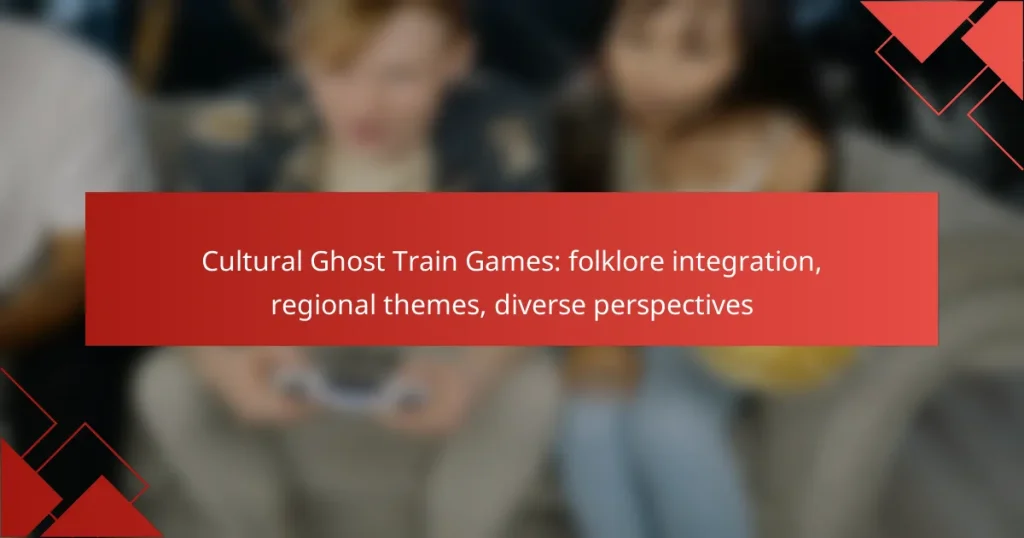Cultural ghost train games uniquely blend local folklore with interactive storytelling, allowing players to engage deeply with their cultural heritage. By incorporating regional themes and diverse perspectives, these games create immersive experiences that highlight traditional myths and community values, fostering a rich narrative landscape that resonates across different cultures.
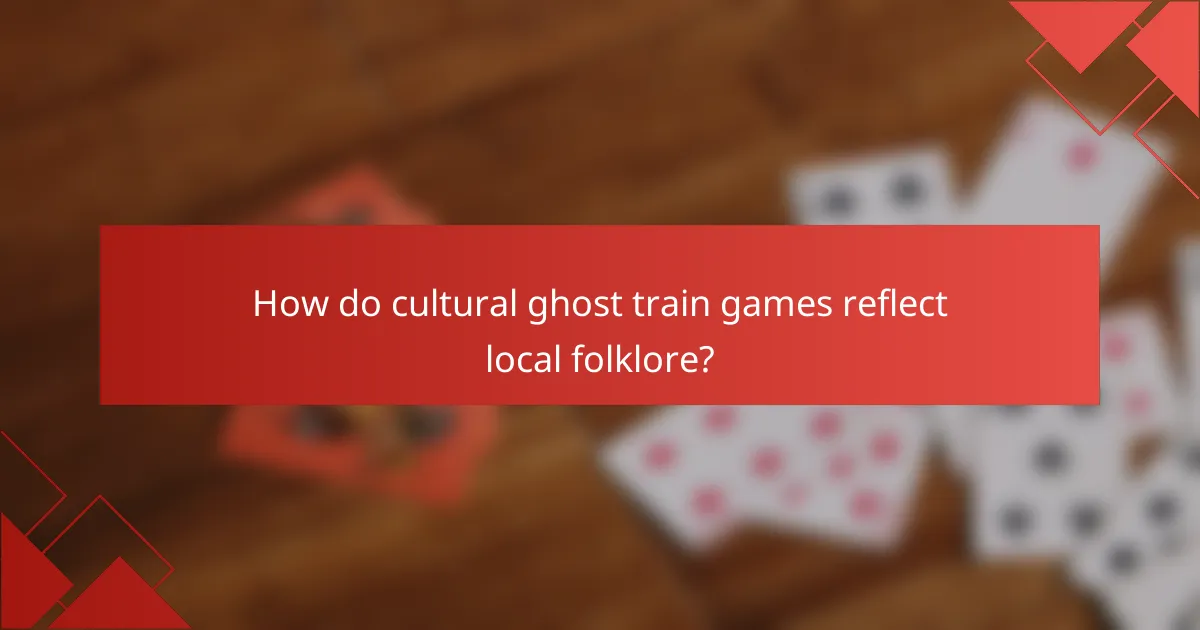
How do cultural ghost train games reflect local folklore?
Cultural ghost train games serve as a vivid representation of local folklore, integrating regional stories and beliefs into their narratives and gameplay. These games often draw on traditional myths, local legends, and community values, creating immersive experiences that resonate with players’ cultural backgrounds.
Integration of local myths
Local myths are central to the design of ghost train games, as they provide the thematic foundation for the stories told within the game. For instance, a ghost train game set in Ireland might feature tales of the Banshee or the Dullahan, while one in Japan could incorporate Yurei or other spirits from Shinto beliefs. This integration not only enhances the authenticity of the experience but also educates players about their cultural heritage.
Game developers often collaborate with local historians or folklore experts to ensure accurate representation of these myths. This collaboration helps in crafting narratives that are both engaging and respectful of the cultural significance behind the stories.
Symbolism in gameplay
Symbolism plays a crucial role in ghost train games, where elements of gameplay often reflect deeper cultural meanings. For example, certain colors, characters, or settings may symbolize specific cultural beliefs or values. In many cultures, the color red can signify protection against evil spirits, which might be represented in the game through protective charms or barriers.
Additionally, gameplay mechanics may incorporate symbolic actions, such as lighting lanterns to guide lost souls or solving puzzles that reflect moral lessons from local folklore. These elements not only enhance the gameplay but also encourage players to engage with the cultural narratives on a deeper level.
Community storytelling
Community storytelling is a vital aspect of cultural ghost train games, as they often serve as a platform for sharing local tales and experiences. Players may encounter narratives that reflect the collective memory of their community, fostering a sense of belonging and shared identity. This storytelling aspect can be further enhanced through interactive elements, where players contribute their own stories or interpretations of local folklore.
Events or competitions related to ghost train games can also encourage community participation, allowing players to showcase their own folklore-inspired creations. This not only strengthens community ties but also preserves and revitalizes local traditions, ensuring that they remain relevant for future generations.
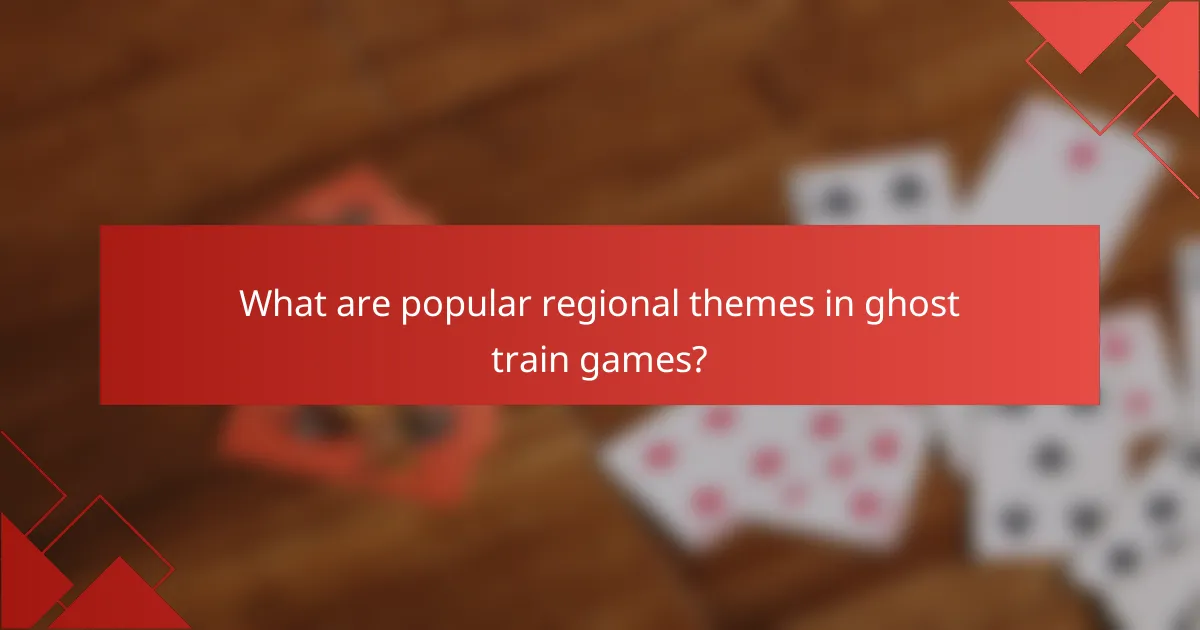
What are popular regional themes in ghost train games?
Ghost train games often draw on regional themes that reflect local folklore and cultural narratives. These themes enhance the immersive experience by connecting players to the unique ghost stories and traditions of different areas.
Appalachian ghost stories
Appalachian ghost stories are steeped in the rich folklore of the region, often featuring spirits of the deceased who linger in the mountains and valleys. Common themes include lost souls seeking closure or revenge, often tied to historical events or local legends.
When designing ghost train experiences based on these stories, consider incorporating elements like traditional Appalachian music, scenic mountain landscapes, and local ghost towns. This can create an authentic atmosphere that resonates with players familiar with the culture.
Mexican Day of the Dead
The Mexican Day of the Dead (Día de los Muertos) offers a vibrant theme for ghost train games, celebrating the lives of those who have passed. This holiday emphasizes the connection between the living and the dead, featuring colorful altars, sugar skulls, and marigold flowers.
Incorporating this theme into a ghost train can involve interactive elements like creating altars or sharing stories of loved ones. Utilizing traditional music and visuals can enhance the experience, making it both respectful and engaging for participants.
Japanese Yūrei legends
Japanese Yūrei legends focus on restless spirits who have not found peace due to unresolved issues in their lives. These ghostly figures are often depicted as ethereal beings in white funeral garments, haunting specific locations tied to their past.
To effectively integrate Yūrei themes into ghost train games, consider using atmospheric settings like traditional Japanese temples or rural landscapes. Incorporating elements of Japanese culture, such as folklore narratives and ambient soundscapes, can create a haunting yet captivating experience for players.
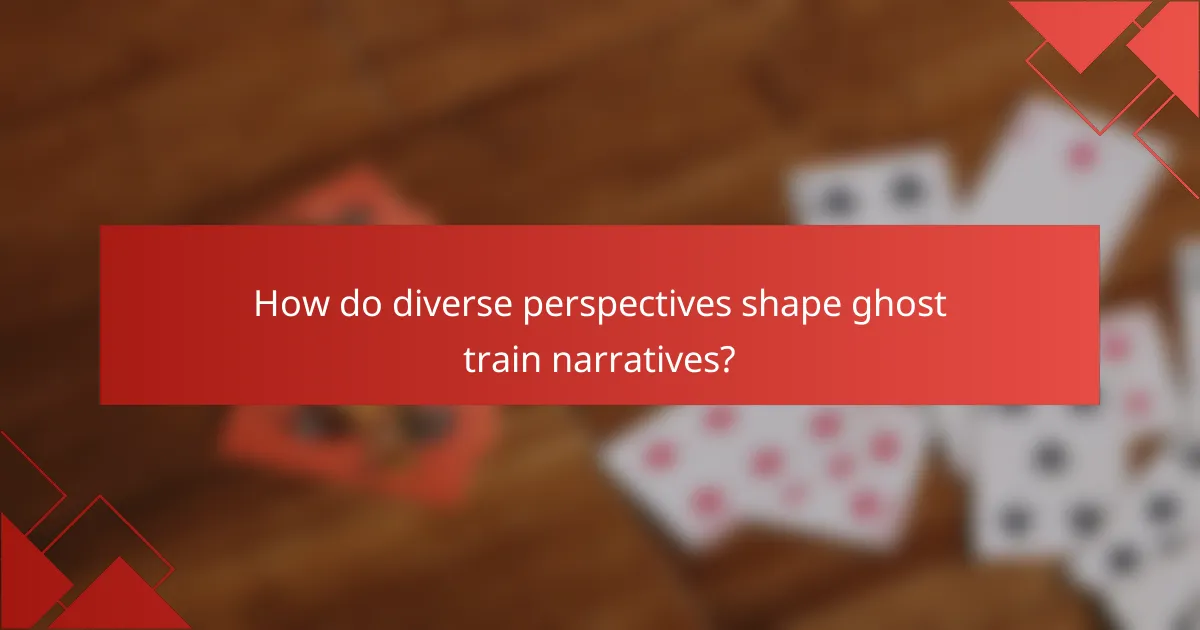
How do diverse perspectives shape ghost train narratives?
Diverse perspectives significantly enrich ghost train narratives by incorporating various cultural beliefs, experiences, and folklore. This integration creates a more complex and engaging storytelling environment that resonates with a wider audience.
Inclusion of marginalized voices
Incorporating marginalized voices into ghost train narratives allows for a more authentic representation of cultural experiences. These perspectives often highlight unique folklore and local legends that may otherwise be overlooked, providing depth to the stories. For example, including Indigenous tales can reveal connections to land and spirituality that enhance the overall narrative.
Engaging with these voices can also foster community involvement, encouraging local storytellers to share their histories. This not only preserves cultural heritage but also invites audiences to connect with the stories on a personal level.
Cross-cultural collaborations
Cross-cultural collaborations in ghost train narratives can lead to innovative storytelling that blends different traditions and themes. By working together, creators can merge folklore from various cultures, resulting in unique narratives that appeal to diverse audiences. For instance, a ghost train experience might combine elements of Japanese Yurei with Western ghost stories, creating a rich tapestry of horror and intrigue.
These collaborations also promote understanding and appreciation of different cultural backgrounds. They can serve as a platform for dialogue, allowing participants to explore and celebrate their differences while finding common ground in shared fears and myths.
Impact of globalization
Globalization has a profound impact on ghost train narratives by facilitating the exchange of stories and cultural elements across borders. This interconnectedness allows for the blending of local folklore with global themes, creating narratives that resonate with a broader audience. For example, a ghost train attraction in Europe might incorporate Asian ghost stories, appealing to tourists from various regions.
However, globalization can also lead to cultural homogenization, where unique local elements are overshadowed by dominant narratives. It is crucial for creators to balance global influences with authentic local traditions to maintain the integrity of the stories being told.

What are the key elements of successful ghost train game design?
Successful ghost train game design hinges on engaging storytelling, immersive environmental design, and interactive gameplay mechanics. These elements work together to create a captivating experience that resonates with players and reflects cultural folklore.
Engaging storytelling techniques
Storytelling is central to ghost train games, as it immerses players in a narrative that often draws from local folklore. Incorporating regional myths and legends can enhance the authenticity of the experience, making it more relatable and engaging for players.
Utilizing various narrative techniques, such as branching storylines or character-driven plots, can keep players invested. For instance, players might encounter different outcomes based on their choices, encouraging multiple playthroughs and deeper exploration of the story.
Immersive environmental design
Environmental design sets the tone for ghost train games, creating an atmosphere that reflects the eerie and mysterious nature of the narrative. Using soundscapes, lighting, and visual elements that align with local ghost stories can enhance immersion.
Design elements such as detailed scenery, props, and interactive features should evoke the cultural context of the folklore being represented. For example, incorporating traditional symbols or architecture can deepen the connection between the game and its cultural roots.
Interactive gameplay mechanics
Interactive gameplay mechanics are essential for engaging players and making them feel part of the story. Incorporating puzzles, challenges, or decision-making scenarios can enhance player involvement and create a sense of agency.
Consider using mechanics that allow players to uncover secrets or interact with the environment in meaningful ways. For instance, players might solve riddles related to local legends to progress, reinforcing the cultural themes while keeping the gameplay dynamic and fun.

How can developers incorporate folklore into game mechanics?
Developers can integrate folklore into game mechanics by designing quests, characters, and aesthetics that reflect regional myths and cultural narratives. This approach not only enriches gameplay but also fosters a deeper connection between players and the cultural heritage represented in the game.
Folklore-based quests
Folklore-based quests can immerse players in narratives that are rooted in local legends and traditional stories. For instance, a quest might involve retrieving a lost artifact tied to a regional myth, encouraging players to explore the lore behind it. Developers should ensure that these quests are not only engaging but also respectful and accurate representations of the folklore.
To create effective folklore-based quests, consider incorporating elements such as local landmarks or historical events that resonate with the community. This can enhance player engagement and provide educational value, making the experience both entertaining and enlightening.
Character development through myths
Character development can be significantly enriched by drawing on myths and legends. By creating characters that embody traits from folklore, developers can add depth and relatability. For example, a character inspired by a trickster figure might have unique abilities that reflect cunning and resourcefulness.
It’s important to balance character traits with gameplay mechanics to ensure that they are not only thematically appropriate but also functional within the game. Developers should also consider how these characters evolve through interactions with the game’s folklore, allowing players to experience personal growth alongside cultural narratives.
Use of traditional music and art
Incorporating traditional music and art into games can enhance the immersive experience and reinforce the cultural themes present in the gameplay. Using local instruments or musical styles can evoke the essence of a particular culture, making the game world feel authentic and alive.
Art style should also reflect the cultural context of the folklore being represented. This might include using traditional patterns, colors, or motifs that are recognizable to players familiar with the culture. Developers should collaborate with local artists and musicians to ensure authenticity and respect for the cultural elements being incorporated.
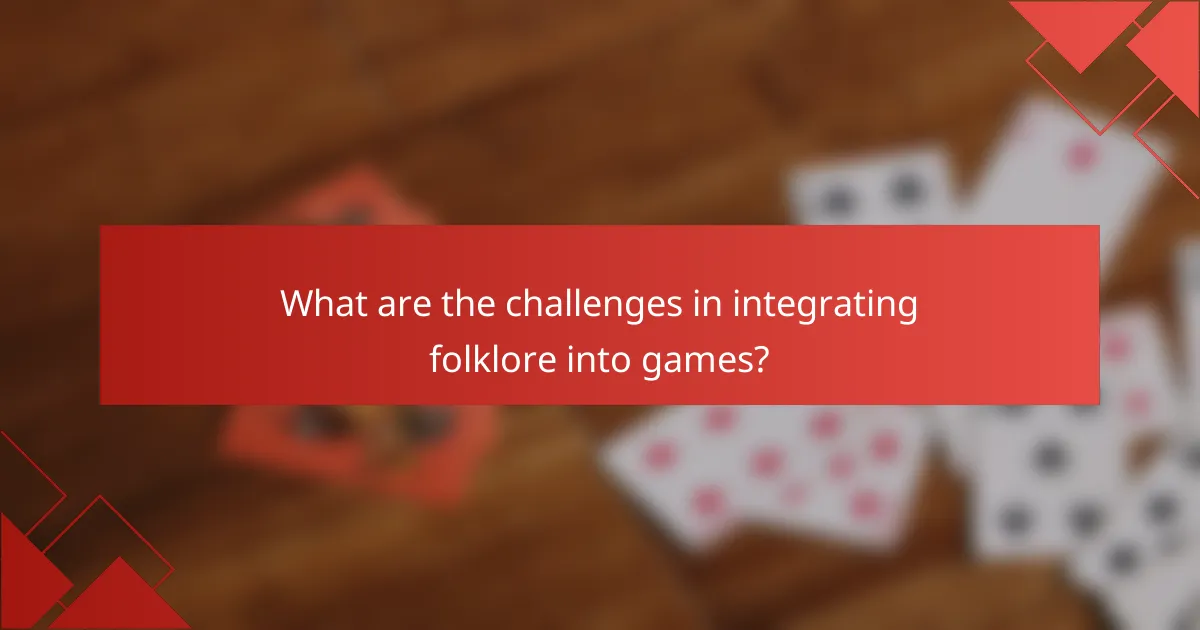
What are the challenges in integrating folklore into games?
Integrating folklore into games presents several challenges, primarily revolving around cultural sensitivity and the need to balance authenticity with entertainment. Developers must navigate the complexities of representing diverse traditions accurately while ensuring the gameplay remains engaging and enjoyable for a broad audience.
Cultural sensitivity issues
Cultural sensitivity is crucial when incorporating folklore into games, as misrepresentation can lead to offense and alienation of communities. Developers should engage with cultural experts and representatives to ensure that the narratives and symbols used are respectful and accurate. This collaboration can help avoid stereotypes and promote a deeper understanding of the cultures being represented.
Additionally, it’s essential to consider the historical context of the folklore. Some stories may have deep-rooted significance that could be trivialized in a gaming context. Taking the time to research and understand these narratives can prevent cultural appropriation and foster a more authentic experience.
Balancing authenticity and entertainment
Finding the right balance between authenticity and entertainment is a key challenge when integrating folklore into games. While players appreciate accurate representations, they also seek engaging gameplay and compelling narratives. Developers should aim to create a blend that honors the source material while enhancing the gaming experience.
One effective approach is to incorporate folklore elements in a way that supports gameplay mechanics. For example, using traditional myths as the basis for quests or character abilities can create a rich narrative without sacrificing fun. Testing with diverse player groups can provide valuable feedback on how well the folklore resonates with audiences while maintaining entertainment value.
